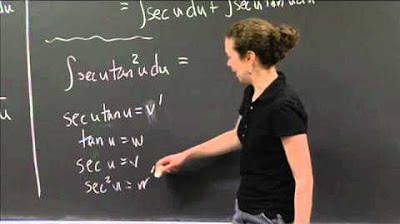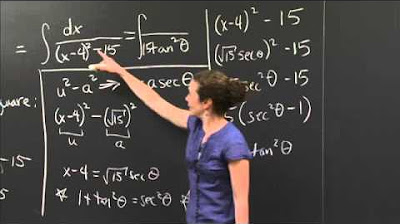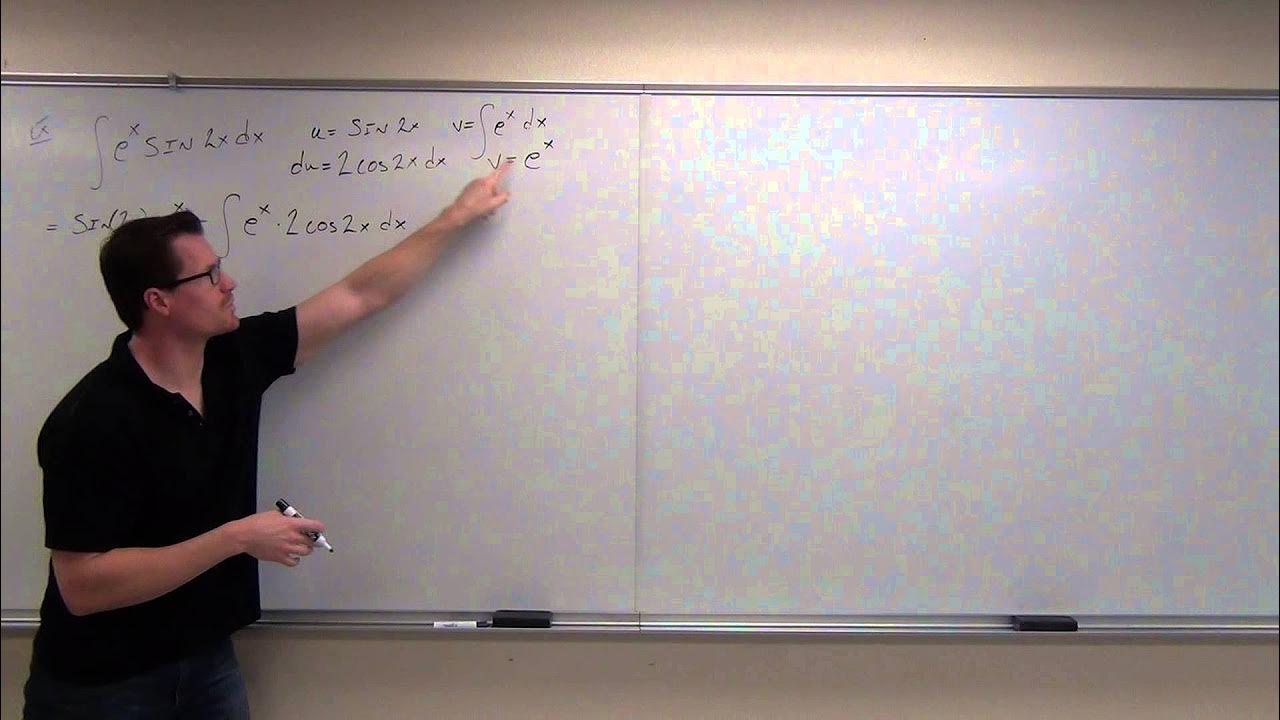Evaluating line integral directly - part 2 | Multivariable Calculus | Khan Academy
TLDRThe speaker walks through the process of evaluating a trigonometric integral, emphasizing the use of U-substitution and trigonometric identities. They break down the steps to rewrite the integral into a more manageable form, showing how to integrate each part. The calculation involves transforming and simplifying the integral, using common trigonometric identities and properties of derivatives. Ultimately, the integral simplifies to the value of pi after evaluating it at the given limits. The detailed explanation provides a step-by-step guide to understanding and solving complex trigonometric integrals.
Takeaways
- 📚 The integral in question is primarily an exercise in evaluating trigonometric integrals.
- 🔍 There's no direct way to integrate sine cubed theta, but it can be simplified using trigonometric identities.
- 📈 The script demonstrates rewriting sine squared theta as 1 - cosine squared theta to make integration easier.
- 🌀 The process involves multiplying out the expression to get sine theta minus sine theta cosine squared theta.
- 📉 The antiderivative of sine theta is negative cosine theta, making it straightforward to integrate once simplified.
- 📊 Cosine squared theta is rewritten using the identity as 1/2(1 + cosine of 2 theta) for easier integration.
- 🔄 The integral is broken down into parts that are easier to integrate, such as terms involving cosine and sine functions.
- ✂️ U-substitution is used implicitly to integrate terms involving cosine theta and its derivatives.
- 📐 The antiderivative of 1/2 with respect to theta is 1/2 theta, showcasing basic integration techniques.
- 🔢 The derivative of 2 theta is used to simplify the integration of cosine 2 theta, resulting in sine of 2 theta.
- 🧩 The final expression is evaluated between 0 and 2 pi, simplifying the complex integral to a straightforward calculation.
- 🥁 The final result of the integral simplifies to pi, demonstrating the power of trigonometric identities in integration.
Q & A
What is the main topic of the video script?
-The main topic of the video script is evaluating a trigonometric integral, specifically the integral of sine cubed theta.
Why is the integral of sine cubed theta not directly integrable?
-The integral of sine cubed theta is not directly integrable because there is no obvious antiderivative for sine cubed theta without a mixture of sines and cosines.
What trigonometric identity is used to rewrite sine squared theta?
-The trigonometric identity used to rewrite sine squared theta is 1 - cosine squared theta.
How is the integral simplified after rewriting sine squared theta as 1 - cosine squared theta?
-The integral is simplified by expressing it as sine theta minus sine theta cosine squared theta, making it easier to integrate due to the presence of the derivative of cosine theta.
What substitution is used to integrate the expression involving cosine squared theta?
-The substitution used is to express cosine squared theta as 1/2 of 1 plus cosine of 2 theta, which simplifies the integration process.
What method is used to integrate the term involving cosine of 2 theta?
-The method used to integrate the term involving cosine of 2 theta is to recognize the derivative of 2 theta and apply the antiderivative of half cosine 2 theta, resulting in sine of 2 theta.
How is the antiderivative of sine theta expressed in the script?
-The antiderivative of sine theta is expressed as negative cosine theta in the script.
What is the purpose of the U-substitution mentioned in the script?
-The purpose of the U-substitution mentioned is to simplify the integration process by making use of the derivative of cosine theta.
How does the script handle the evaluation of the integral between 0 and 2 pi?
-The script handles the evaluation by taking the antiderivative of each term and then evaluating the entire expression at the limits 0 and 2 pi, and subtracting the results.
What is the final result of the integral after evaluating between 0 and 2 pi?
-The final result of the integral after evaluating between 0 and 2 pi is pi, as all other terms cancel out or evaluate to zero.
Outlines
📚 Step-by-Step Trigonometric Integral Evaluation
The first paragraph of the script introduces the task of evaluating a trigonometric integral, emphasizing the importance of practice in this area. The integral in question involves sine cubed theta, which is not straightforward to integrate directly. The speaker suggests rewriting the integral using trigonometric identities to simplify it. This involves expressing sine squared theta as 1 minus cosine squared theta and further breaking it down into terms involving sine and cosine, which are easier to integrate. The process involves recognizing common trigonometric identities and applying U-substitution to find the antiderivative of each term. The paragraph concludes with the integral expressed in a form that is ready for integration, setting the stage for the next steps.
🔍 Evaluating the Integral at Boundaries
The second paragraph focuses on the practical evaluation of the integral by applying the antiderivative to each term and evaluating the result at the boundaries of the integration interval, which are 0 and 2 pi. The speaker calculates the value of each term at these points and simplifies the expression by subtracting the values evaluated at 0 from those at 2 pi. This step-by-step process leads to a simplified expression involving negative one, one-third, and pi. After canceling out terms, the final result of the integral is found to be pi. The paragraph concludes with a comparison to the simplicity of using Stokes' Theorem, suggesting that in this case, direct evaluation was more straightforward.
Mindmap
Keywords
💡Integral
💡Trigonometric Integrals
💡Antiderivative
💡U-Substitution
💡Sine Squared Theta
💡Cosine Squared Theta
💡Chain Rule
💡Derivative
💡Evaluation at Points
💡Stokes' Theorem
💡Simplification
Highlights
Introduction to evaluating trigonometric integrals with sine cubed theta.
No direct way to take the antiderivative of sine cubed theta, suggesting a mixture of sines and cosines for U-substitution.
Writing sine cubed theta as a product of sine theta and sine squared theta.
Rewriting sine squared theta as 1 minus cosine squared theta.
Expanding the expression to facilitate easier integration.
Using the derivative of cosine theta to simplify the integral.
Expressing cosine squared theta as 1/2 of 1 plus cosine of 2 theta using a trigonometric identity.
Rewriting the integral into a form that is easier to take the antiderivative of.
Integrating each term step by step, starting with sine theta.
Using substitution for the antiderivative of cosine theta.
Integrating 1/2 with respect to theta to get 1/2 theta.
Dealing with the derivative of cosine 2 theta by multiplying and dividing by 2.
Integrating 1/2 half cosine 2 theta to get sine of 2 theta.
Integrating cosine theta to get sine theta and simplifying the expression.
Integrating the last part of the expression involving sine squared theta.
Evaluating the antiderivative at the limits 0 and 2 pi.
Simplifying the evaluated expression to get the final result of pi.
Transcripts
Browse More Related Video

Integration Practice II | MIT 18.01SC Single Variable Calculus, Fall 2010

Lesson 16- Integration By Trig Substitution (Calculus 1 Tutor)

Integration by completing the square | MIT 18.01SC Single Variable Calculus, Fall 2010

Calculus 2 Lecture 7.1: Integration By Parts

Changing the Order of Integration (Double Integrals)

Calculus 1: U-Substitution Examples
5.0 / 5 (0 votes)
Thanks for rating: